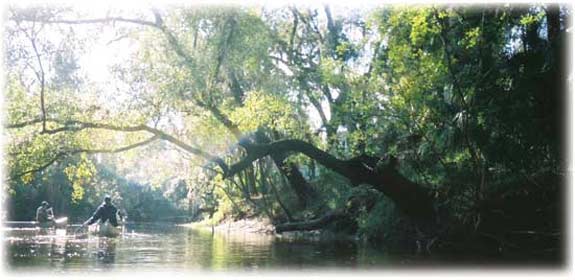
On a crisp November morning, District staff and members of the Alafia River Basin Board launched four canoes into the Alafia River. The basin includes the southern half of Hillsborough County and the southwestern portion of Polk County. The Basin Board members set out to experience the river — the most important part of the basin — and to talk with some concerned citizens who live along the river.
The canoe trip took place along part of the 13-mile portion of the river officially designated as the Alafia River Canoe Trail, a part of Florida’s statewide system of greenways and trails. The narrow, twisting trail begins at Aldermans Ford County Park and ends at the Bell Shoals Road Bridge. This portion of the river can be swift.
The banks of the river are lined with large oak, cypress and cedar trees, allowing paddlers to enjoy the peace and quiet with wading birds and turtles.
The 2004 hurricanes felled many trees along the banks and blocked portions of the river. The obstacles presented safety and flooding concerns. Because of the size of the project, the District hired a contractor to clear the river.
The debris removal project led to some discussion about what happens when a tree falls and blocks the river. Who is responsible for making sure the river is navigable? If it does not pose a flood risk, is it anyone’s responsibility to make sure the river is clear for recreational use? Most of the public land along the river is owned by the state and Hillsborough County, not the District.
The issue is important to Karen and Daryl Wagner because this portion of the river is designated as a state canoe trail. The Wagners live along the canoe trail and are members of the Alafia River Basin Stewardship Council, which is interested in keeping the river clean and beautiful. The group conducts cleanups along the river and is part of the streamwater watch network. They also organize the annual Alafia Challenge Race, a canoe race that attracts hundreds of participants.
“Our organization uses money from the race to put it back into projects that benefit the river,” said Karen Wagner.
“We know the District is not responsible for maintaining the river,” said Daryl Wagner. “And we aren’t worried about every tree that falls, that’s a natural occurrence. What we’re concerned with is what do we do when big trees block the entire river?”
Sybil Cribbs, owner of Alafia River Canoe Rental, says the occasional tree in the way is not a concern. “No one has complained about obstructions; they enjoy the challenge and either go around it or climb over it,” said Cribbs.
If a tree is too large, she says someone they know will go out and cut a path so people can pass through. Hillsborough County Parks, Recreation and Conservation Department staff will cut paths when called, and other private citizens also do minor clearing.
Staff and Board members also talked to residents about the river’s unpredictable water levels. During the rainy season or heavy storms, the river can rise several feet within a few hours or overnight.
During the discussion, Mark Hammond, District resource management director, asked the Wagners how often the river crests above the banks and what is the highest level they’ve seen the river.
The Wagners have lived in their home since 1995. The highest they’ve seen the river at was 22.1 feet after the 2004 hurricanes.
“Based on research I’ve seen, the only time it was higher than that was in the 1960s after Hurricane Donna,” said Cammy Hinton, Alafia River Basin Board member. Hinton and fellow Board members Stephen Bissonnette and J. C. Tort all participated in the tour.
Hammond also asked the Wagners about the county’s emergency operation efforts to call residents along the river as it begins to rise and near flood stages. The Wagners said the system works well overall. They also talked about how the county maintains a system for residents to access the information online, but sometimes residents don’t have access during storm events because of power outages or other reasons. They are working with the county to address that issue.
District staff and Basin Board members wrapped up their canoe trip at Lithia Springs Park.
“Actually getting out on the river and meeting with citizens face to face is very helpful,” said Lou Kavouras, District deputy executive director. “To get a firsthand look at what the Board members are reading about helps them put things in perspective and make better decisions on how to protect our water resources.”
